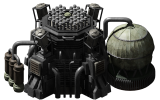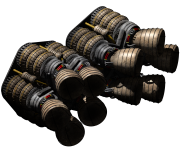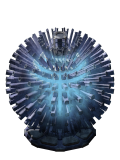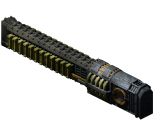
Outfitting Your Ship
All ships need, at a bare minimum, a steering system and thruster, and a power source to drive them. To travel between star systems, a ship also needs a hyperdrive. Each ship chassis also comes with some things built in. For example, all ships have a hull, and except for unmanned drones the hull will include an integrated energy shield matrix that provides defense in combat and also protects the crew from chronic exposure to cosmic radiation. Most ships also have hardpoints designed for mounting forward-facing guns or omnidirectional gun turrets, and a few ships have bays for fighters and drones.
Each ship has a limited amount of space for outfits. In addition, ships also have a limit on the total size of weapons installed, and of engines. Some ships have ample engine space, but very little space for weapons; in other ships, the reverse is true. This means that, for example, it is not possible to replace a Sparrow’s two small beam lasers with two massive particle cannons, even if the engines are downgraded to something smaller in order to make room.
Ships and outfits depreciate (lose value) over time. Three years after you bought a ship, it will only sell for 25% of its original value. Plundered outfits and captured ships also only sell for 25% of their value.

Power Sources
On most ships, a central generator produces electricity, which is then stored in batteries until needed. The batteries allow the ship to temporarily draw more power than its generator produces, for example to fire a weapon salvo. It is possible to forgo the batteries entirely if your ship’s instantaneous power draw will never exceed the output of its generator, but without batteries you may not be able to fire weapons like energy blasters that fire in discrete bursts instead of a continuous stream.
Generators come in a variety of sizes, prices, and power levels. Most small ships will use a fuel cell of some sort. More efficient and expensive generators are also available in some parts of human space. Batteries also come in a range of capacities, and are much cheaper than generators. The balance between battery size and generator size depends on your budget. If you can afford it, it is best to have a powerful generator even if that means there is only room left for very small batteries, because otherwise once your batteries are empty you will have to retreat from combat until they recharge.
If your ship is short on energy, engines take priority over weapons. If the engines draw enough power, it is even possible that once your batteries are depleted you will not be able to steer and apply forward thrusters at the same time. In their stock configurations, most ships have engines and generators balanced well enough that this will not happen, but a common mistake made by rookie pilots is to install overpowered engines without having the means to drive them continuously.

Engines
Most human ships use either ion drives or plasma drives. Ion drives are more energy-efficient; plasma drives are more space-efficient. Plasma drives also produce more heat, so if you install them along with other outfits that generate heat, your ship may be in danger of overheating. Ion drives are the older and more mature technology, and are available throughout most of human space; plasma drives are produced by Delta V Corporation, in the galactic south, and may be hard to find in other parts of the galaxy. A few worlds in the Deep sell atomic engines, which are more powerful but also very expensive and energy-hungry.
Each engine type is available in a variety of sizes, and there is nothing stopping you from installing, for example, two small sets of thrusters instead of one large one, or even an ion thruster and a plasma thruster side by side. However, a larger thruster will always be more efficient that two smaller ones that add up to the same size.
Because thrusters and steering systems are sold separately, you must also balance how important it is for you to be able to turn quickly, versus being able to move quickly. If your ship has mostly forward-facing guns, quick steering is essential in order to be able to track your targets. If it has mostly turrets, you might forgo the better steering capability in favor of a higher maximum speed. And of course, you may also decide to install smaller engines in order to use some of the engine space for holding a bigger generator or other bulky systems.
Your acceleration and turn rate also depend on your ship’s mass: the bigger the ship and the more cargo it is carrying, the slower it will turn.

Hull and Shields
Although most pilots today think of energy shields as purely for protection in combat, they were originally designed as a defense against cosmic radiation. Later, they were strengthened enough to deflect micro-asteroids and other space debris. These early shield generators created a spherical ring around the ship, generally at some distance away from the hull because a powerful enough impact could distort the field and bend it inward.
That was back in the early days of interstellar travel. Today’s integrated shield matrices are an order of magnitude more powerful and efficient, in part because they are custom-fitted to the shape of a ship rather than extending far outside it. But because the emitters that maintain the shield matrix are integrated into the hull, you cannot increase the strength by swapping in a different generator; the only way to significantly boost your shield strength is to buy a stronger ship.
Instead, modern shield generators serve only to recharge the matrix, which is still a very useful function, especially if you are able to gain a brief respite from combat. Some shield generators, in fact, are so powerful that they can keep shields at full strength even when under constant fire from an energy blaster. Recharging shields takes energy, but typically much less energy than your other systems draw.

0 commenti:
Post a Comment